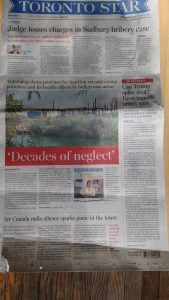Enviro watchdog blasts province for inaction on ‘outrageous’ pollution in Indigenous communities
Ontario environmental commissioner Dianne Saxe condemned government inaction in Sarnia’s Chemical Valley and Grassy Narrows.
The Ontario government has, for decades, turned a blind eye to “outrageous” pollution causing serious health effects in Indigenous communities, the province’s environment watchdog said Tuesday.
In the annual report delivered to Queen’s Park, Ontario environmental commissioner Dianne Saxe recognized recent progress, but condemned years of inaction by the provincial government in the Aamjiwnaang First Nation in Sarnia’s Chemical Valley, and in mercury-contaminated Grassy Narrows in northwestern Ontario. Both have been subjects of investigations by journalists, including those of the Star.
“The conditions faced by these Indigenous communities would not be tolerated elsewhere in Ontario, yet have long been deemed unworthy of priority, effort or expense,’ said Saxe. “After decades of neglect, the province is finally taking some steps, but the pollution that these communities still face is outrageous.”
A joint investigation by the Star, Global News, National Observer, the Michener Awards Foundation and journalism schools at Ryerson and Concordia universities revealed a troubling pattern of secrecy and potentially toxic leaks in the area known as Chemical Valley. There are 57 polluters within 25 kilometres of Sarnia registered with the Canadian and U.S. governments.
The investigation raised questions about whether companies and the provincial government are properly warning residents of Sarnia and Aamjiwnaang when potentially toxic substances, including benzene, known to cause cancer in high levels of long-term exposure, are leaked. Aamjiwnaang is surrounded on three sides by petrochemical plants.
In the report, Saxe said there is “strong evidence” to suggest pollution is causing “profound” health problems in Aamjiwnaang, which neither the federal nor provincial governments have properly investigated.
Following the joint investigation, provincial Environment Minister Chris Ballard committed to funding a study examining the health effects of pollution in the Chemical Valley, something residents had sought for nearly a decade.
But Saxe said the government still needs to take the cumulative effects of pollution into account, do more air-monitoring, update regulations and properly enforce those on the books. It currently ignores some forms of common emissions, such as those from flares, used to burn off materials dangerous to plants.
Last week, Aamjiwnaang resident Vanessa Gray filed a request for the province to investigate a flaring incident caught on video at Sarnia’s Imperial Oil plant from February 2017, where clouds of fire and steam billowed from its smokestacks for hours. Gray said the episode caused a burning sensation in her nose.
“It is wonderful that the government’s going to do a health study, but what they really need to do is clean up the air,” Saxe told reporters.
Ron Plain, who has spent the past 25 years living in Sarnia and Aamjiwnaang, said he hopes Saxe’s report will open the eyes of those who thought the issue isn’t that bad. Plain has cancer; the 55-year-old’s doctors have told him he’ll likely be dead in a year.
“It’s about time,” Plain said of Saxe’s report. “I live it . . . . Everybody here is living it.”
Speaking to media at Queen’s Park Tuesday, Aamjiwnaang Chief Joanne Rogers said nothing in Saxe’s report was new; the community has long asked for action, and Saxe isn’t the first commissioner to identify the issues.
But Rogers said she’s confident change can happen this time if the First Nation is included in discussions going forward.
“We breathe that air, so why is there delay after delay?” she said.
In her report, Saxe recommended the provincial environment ministry post real-time air monitoring data for the people of Aamjiwnaang — a plan to do so is already in the works — and update air standards for sulfur dioxide, a component of acid rain that can cause a range of health issues, even below the threshold where humans are able to smell it.
In response, Ontario Environment Minister Chris Ballard said his ministry will soon release new sulfur dioxide regulations, updating laws set in 1974 that haven’t been revised since. In her report, Saxe said the current standard doesn’t protect human health, and this is something the government has been aware of for years.
“I don’t think our government has been slow to respond to these issues,” Ballard said when asked if institutional racism was a factor in the government’s delayed responses in Aamjiwnaang and Grassy Narrows.
“A lot has been done. A lot more has to be done.”
On Friday, a statement released by Rogers and the First Nation’s council suggested the issues in Chemical Valley may be a violation of the United Nations Declaration of the Rights of Indigenous Peoples. The declaration says Indigenous communities have the right to the “conservation and protection of the environment and the productive capacity of their lands or territories and resources.”
Saxe’s report, delivered Tuesday, also condemned government inaction on mercury poisoning in the Grassy Narrows and Wabaseemoong First Nations near Dryden, Ont. Contamination of the Wabigoon River there has sickened residents for generations; the most recent study found 58 per cent of community members are either diagnosed with or suspected of having Minamata disease, a severe neurological illness caused by mercury poisoning.
“[T]he Ontario government declined to take action for decades, largely ignoring the suffering of the Grassy Narrows and Wabaseemoong peoples. Over and over, the Ontario government chose to do nothing. It chose not to remove the sediment, not to investigate in more detail, not to monitor whether mercury levels were indeed declining. In other words, it chose to allow the ongoing poisoning of the communities,” the commissioner wrote in the report.
After a nearly year-long Star investigation that found, among other things, mercury tainted soil upstream from Grassy Narrows, the province committed earlier this year to paying $85 million to clean up the contamination.
Mercury survivor and Grassy Narrows environmental health coordinator Judy Da Silva said those already poisoned are still facing “hopelessness” and a lack of support.
“We’ve been so ignored for decades that our people are in disbelief of anything ever changing,” she said.
Saxe’s report also called attention to the 36 First Nations communities in Ontario under water advisories, including 17, which have been without a safe water source for more than a decade. Although the problem is the federal government’s responsibility, the provincial government can and should help by protecting water sources and by providing more technical training, Saxe said.
“The Ontario government must make environmental justice part of its pursuit of reconciliation with Indigenous people.”






